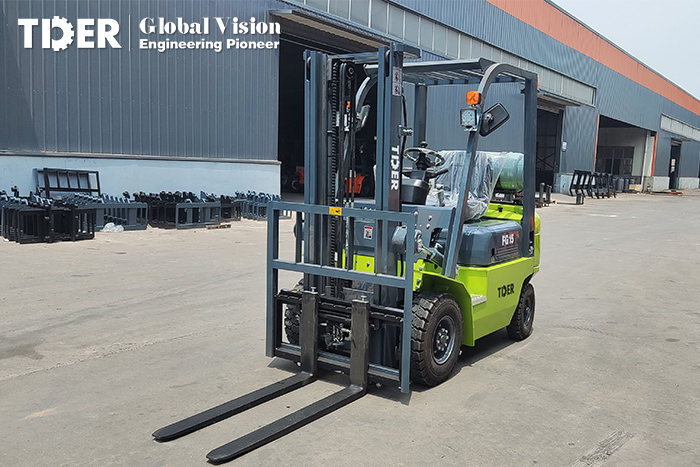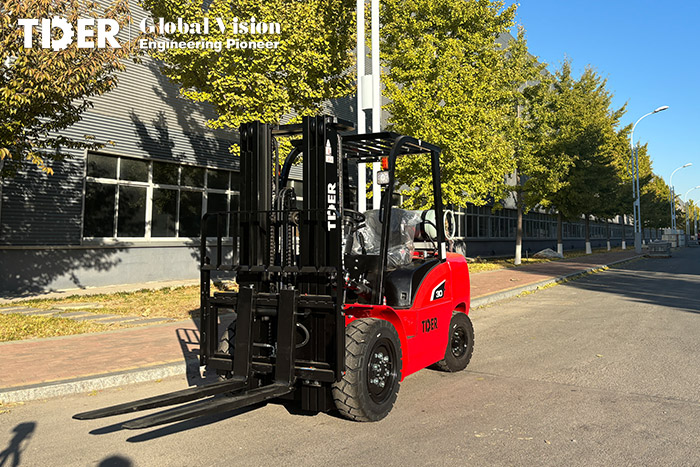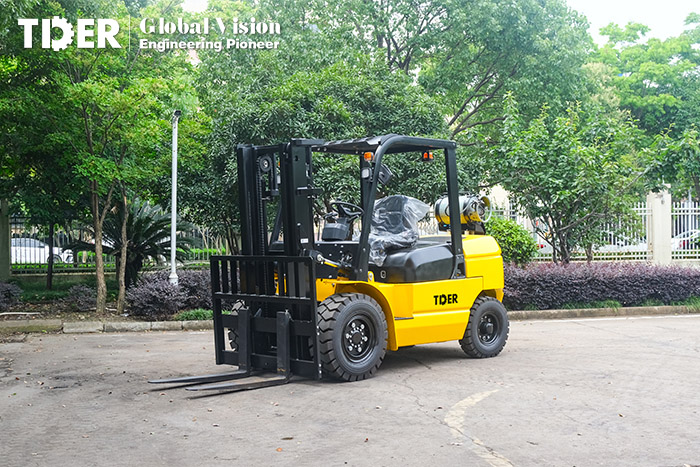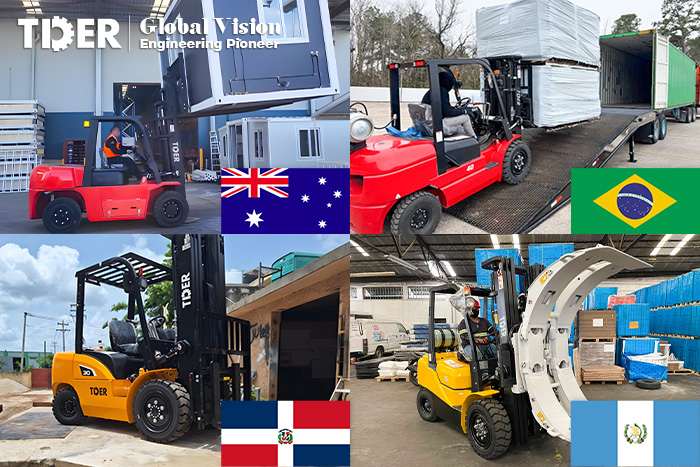I. Balancing Green and Economy: New Market Demand
In recent years, with the advancement of global carbon‑neutrality goals and the tightening of environmental regulations in various countries, the material‑handling industry is facing unprecedented pressure to transition to greener operations. In warehousing, logistics, ports and other scenarios, tailpipe emissions and noise are increasingly regulated. Traditional diesel forklifts, due to high emissions and fuel consumption, are gradually being restricted. At the same time, the long‑term high volatility of international oil prices continues to push up operating costs, increasing the pressure on the use of fuel‑powered forklifts.
Against this backdrop, more and more material‑handling enterprises are opting for liquefied petroleum gas dual-fuel LPG/Gasoline Forklift. These machines not only effectively reduce emissions and comply with environmental regulations but also optimise operating costs through flexible fuel switching and high combustion efficiency. Compared with single‑fuel forklifts, dual‑fuel models offer both economic and environmental benefits, making them the ideal choice for enterprises driven by both policy pressure and cost control. This explains why this type of vehicle is being adopted by more and more companies.

B Series 1.5 Ton LPG/Gasoline Forklift Truck
II. Technical Turning Point: the Emergence and Advantages of Dual‑Fuel Power
Against the backdrop of continuous innovation in forklift power technology, LPG combined with gasoline or diesel in dual‑fuel systems is becoming a focus of industry attention. Such a system allows the forklift to switch freely between two fuels, maintaining the strong output of traditional internal‑combustion power while significantly reducing emissions. When the vehicle is operating in enclosed warehouses or urban environmental zones, it can prioritise the use of LPG, achieving a cleaner combustion process. In outdoor or high‑load conditions, it can switch back to gasoline or diesel to ensure continuous and stable power.
Compared with traditional single‑fuel forklifts, dual‑fuel systems achieve a balance between environmental friendliness and economic efficiency. LPG burns more completely, with lower carbon and particulate emissions than gasoline or diesel engines, and the combustion process is smoother with less noise, effectively improving driver comfort and the work environment. At the same time, the fuel‑switching control system can intelligently adjust the fuel ratio according to operating conditions, thereby reducing fuel consumption while ensuring power performance. Industry estimates show that forklifts adopting dual‑fuel technology can save about 10 % to 20 % on comprehensive operating costs, demonstrating significant economic advantages in multi‑shift, high‑frequency logistics operations.

P Series 3 Ton LPG/Gasoline Forklift Truck
III. Market Trends: Global Policy and Regional Application as Dual Drivers
Driven by global energy transition and carbon‑neutral goals, dual‑fuel forklifts are becoming a new trend in material‑handling equipment. Major markets in Europe, America, Asia and Latin America have introduced green manufacturing and clean‑energy policies, creating a favourable environment for the application of LPG dual‑fuel forklifts.
In Europe, the EU’s Non‑Road Mobile Machinery (NRMM) emission standards are continuously being upgraded, leading to the gradual phase‑out of diesel forklifts from urban warehouses and ports. Governments in the United Kingdom, France, Italy and other countries have introduced green‑equipment subsidy programmes that include LPG and dual‑fuel forklifts in the “low‑carbon recommendation list” to encourage companies to update their fleets and reduce emissions.
The North American market is also at the forefront. The OSHA and EPA in the United States have strengthened operational safety and emission regulations, making LPG/Gasoline Forklift the ideal choice for indoor warehousing, cold‑chain logistics and large distribution centres. Their refuelling is convenient, power stable and not subject to charging downtime, enabling “refuelling and go” and significantly improving operational continuity.
Meanwhile, the Asian market is rapidly rising. Manufacturing and logistics industries in China, Korea, Japan and Southeast Asia are undergoing a transition from high energy consumption to high efficiency. Many local governments in China have promoted low‑emission equipment in industrial parks and logistics hubs, encouraging enterprises to adopt dual‑fuel or new‑energy forklifts to meet both environmental policies and carbon‑reduction goals. Thailand and Indonesia, with abundant and price‑stable LPG resources, have popularised LPG forklifts in ports, food processing and transshipment warehouses.
In Latin America, the Middle East and other regions with diversified energy structures, dual‑fuel forklifts also offer both cost and environmental advantages, becoming an important solution to replace traditional diesel equipment. As green policies take effect and energy prices continue to fluctuate, LPG dual‑fuel forklifts are rapidly entering mainstream global markets because of their characteristics of “low emissions, low costs and high flexibility.”
Overall, the rise of dual‑fuel forklifts is not only the result of policy guidance but also a reflection of rational market choices. They strike a balance between environmental standards and operating costs, combining the power performance of traditional internal‑combustion engines with the environmental advantages of clean energy. Whether in mature markets in Europe and America or in Asia and emerging economies, LPG dual‑fuel forklifts are becoming an important force in the green transformation of the forklift industry, opening a new direction for the sustainable development of global material‑handling equipment.

X Series 5 Ton LPG/Gasoline Forklift Truck
IV. Brand Practice: Technical Application and Product Layout with TDER as an Example
As a global manufacturer of construction machinery and logistics equipment, Xiamen TDER Industrial Co., Ltd. has been committed to providing high‑performance, low‑emission mechanical solutions for the global market since its establishment in 2003. After more than 20 years of technological accumulation and innovative development, TDER’s products have been exported to 158 countries and regions covering South America, Eastern Europe, Southeast Asia, the Middle East and Africa, winning the trust of global customers with stable product performance and high‑quality services.
In response to the global trend of clean‑energy transition, TDER took the lead in launching an LPG/gasoline dual‑fuel forklift series that achieves a balance between power and environmental protection. This series combines the structural strength of diesel models with the clean advantages of LPG power, resulting in more complete combustion and lower emissions. Tests show that TDER’s dual‑fuel forklifts reduce CO₂ and particulate emissions by about 30 % to 40 % compared with traditional diesel forklifts, while maintaining equivalent power output and stable climbing performance.
In product design, TDER focuses on combining reliability and intelligence.
l Power configuration: models of 2–4 tonnes are equipped with Nissan K25 engines, and models of 5–7 tonnes use PSI engines, offering stable performance and cleaner emissions.
l Structural durability: adopting one‑piece cast steering axles and wide‑view masts, the structure is robust and suitable for high‑intensity conditions in ports, warehousing and manufacturing.
l Operating experience: standard features include digital instruments, USB charging ports and intelligent fault‑alarm systems. Options include heated cabins, reversing cameras and air‑filtration systems to meet different climatic and operational needs.
l Maintenance convenience: the electrical system wiring is well designed, and the hydraulic system uses tapered sealing and efficient filtration technology, significantly extending service life and reducing maintenance costs.
In overseas markets, TDER’s dual‑fuel forklifts have been widely used in food processing, warehousing logistics, cold‑chain distribution and indoor handling in urban factories. For example, in a major food‑group project in the Middle East, the customer purchased more than 50 dual‑fuel forklifts for enclosed‑warehouse operations. Compared with the original diesel models, emissions were reduced by 35 % and noise by about 40 %. While meeting environmental requirements, fuel costs decreased by about 20 %. The customer commented: “The dual‑fuel forklifts have found the perfect balance between power and environmental protection and greatly improved the working environment in the workshop.”
At the same time, some customers have raised questions: in today’s emphasis on environmental protection, should we not directly choose electric forklifts? TDER believe s that dual‑fuel forklifts are not a replacement for electric models; rather, they are a green solution with greater flexibility and economy at this stage. Compared with electric forklifts, dual‑fuel forklifts have the following advantages:
l Purchase cost: the purchase price of dual‑fuel forklifts is only about 60 % to 70 % of that of electric forklifts of the same tonnage, resulting in a shorter payback period.
l Energy and environmental adaptability: they do not require expensive charging infrastructure, refuelling is fast, and they are suitable for long‑term continuous operation and low‑temperature, humid environments.
l Ease of maintenance: the system structure is mature and reliable, and maintenance costs are far lower than battery maintenance and replacement costs.
Lower initial investment, no need for charging facilities, faster energy replenishment and adaptability to high‑intensity and complex conditions make dual‑fuel forklifts particularly suitable for areas and industries where charging infrastructure is not yet complete and work rhythms are tight.
With its strong accumulation in mechanical manufacturing and system integration, TDER not only manufactures forklifts but also provides one‑stop solutions covering product customisation, technical support, spare‑parts supply and after‑sales service. In an era that values both energy savings and high efficiency, TDER is leading the forklift industry toward a cleaner and smarter future through technological innovation and sustainable concepts.

TDER Customer Feedback
V. Conclusion and Outlook: Industry Trends and TDER’s Vision
From the perspective of the global energy transition, dual‑fuel forklift technology is not only a transitional solution but also a crucial bridge. Using a mature and stable fuel system, it helps enterprises optimise emissions and balance costs at the current stage, laying a foundation for future transitions to pure electric, hydrogen and other zero‑emission technologies. As environmental regulations tighten and energy structures diversify, dual‑fuel power is becoming an important support for the green transformation of the forklift industry.
Faced with this trend, TDER will continue to deepen its technological layout in clean energy and intelligent manufacturing. From dual‑fuel to electrification, TDER promotes product upgrades with an open innovation mindset and is committed to providing global customers with more environmentally friendly, efficient and intelligent one‑stop handling solutions.
Adhering to the vision of “becoming a world‑class customised machinery company,” TDER not only manufactures machinery but also uses technological innovation to promote industry progress. In the future, TDER will work with global partners to accelerate the green transition and contribute to global sustainable development.



